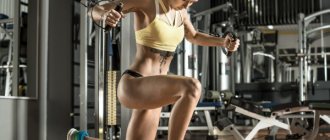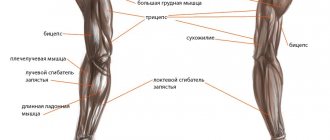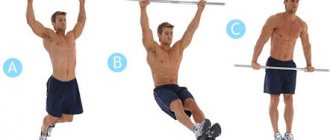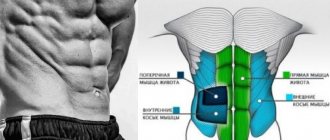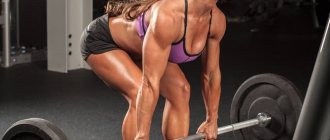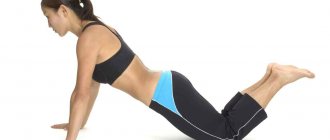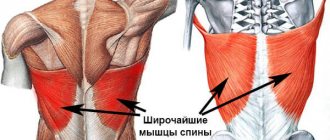A developed back is needed not only by bodybuilders and athletes who strive to build a proportional body. This muscle group is important in strength sports. A muscle corset protects the spine from injury and helps keep it healthy. The back is involved in many exercises, which indicates the need to pay special attention to the training process, for example, with dumbbells, taking into account safety precautions, goals, body characteristics, and so on.
- Back muscle anatomy, muscle strengthening
- Contraindications to exercises with dumbbells
- Basic exercises for the back and lower back with dumbbells
- The best back workout with dumbbells at home
- Deadlift
- Deadlift on straight legs
- Bent leg deadlift
- Bent-over dumbbell row
- Raising dumbbells to the back to the waist
- Bent-over dumbbell raises
- Lateral bends
- Lifting dumbbells to the chin
- General recommendations for performing back exercises with dumbbells
Back muscle anatomy, muscle strengthening
The back muscles are involved in most exercises (with the exception of some isolated movements). This is due to the structural features of the human body in general and the muscle corset in particular.
All back muscles can be divided into several groups:
- latissimus dorsi
- trapezius muscles
- semispinalis capitis muscles.
- splenius capitis muscles
- levator scapula muscle
- serratus posterior superior muscles
- rhomboid major muscles
- erector spinae muscles
- serratus posterior inferior muscles
Back muscles
Back muscle groups
Back muscle groups
Many exercises that are used in the training process immediately develop most of the back muscles. For example, deadlifts (including dumbbells), belt rows, pull-ups, and so on are used as the main load. More experienced athletes supplement their classes with more isolated exercises that are aimed at certain muscles individually. It will be impossible to completely isolate a separate back muscle and pump only one of it due to anatomical features.
Conventionally, athletes divide the back muscles into top, middle and bottom. This or that movement is aimed at developing a certain part, for example, hyperextensions or bending help in developing the lower part (lumbar region), and pull-ups on the bar help the upper part.
Daily program for back training
One example of a program that can be used at home:
- Warm up – 5 minutes.
- Deadlift – 4*8-10.
- Bent-over rows – 4*10-12 (alternate with one and two hands for weeks).
- Chin row – 3*10.
- "Good Morning" - 4*8-10.
- Bent-over dumbbell raises – 3*10.
- Stretching
Contraindications to exercises with dumbbells
Most often, exercises with a barbell are used in the training process. They are easier to learn, and the technique for performing them will be accessible even to beginners. In some cases (in the absence of a barbell during home training, the desire to diversify the process, and so on), dumbbells are used.
The use of dumbbells has a number of contraindications:
- If you have a number of diseases, it is not recommended to put too much strain on your spine. This can only lead to aggravation of the situation.
- The presence of injuries is also a reason to hold off on additional exercise.
- Using dumbbells may be more challenging for beginners. They are not always able to correctly distribute the load or select the right weight. In some cases, it is better to get by with a barbell with a light weight.
- The barbell allows you to perform more basic exercises. Movements with dumbbells are more isolated.
Back pain is a signal of possible problems
If you have back problems, it is recommended to consult a specialist
If you have back problems, it is recommended to consult a specialist
It is worth paying special attention to the presence of other contraindications. Training for high blood pressure should be agreed with a doctor and strictly under the supervision of an experienced trainer. Many pathologies, such as asthma, diseases of the cardiovascular system, hernias and other disorders, can even lead to the exclusion of serious loads, including when working on the back with dumbbells. Sometimes it is better to limit yourself to general strengthening physical education, therapeutic exercises, and so on.
General recommendations
Before you begin exercises for the back muscles with dumbbells, you need to remember a few simple rules and recommendations for maximum effectiveness and safety of the exercises.
Important! Before you start doing exercises with dumbbells, be sure to consult a doctor who will examine your spine and determine whether you have any contraindications to this type of exercise.
The duration of one lesson should not exceed 40 minutes. Start with 15 minutes, gradually working up to the specified time, but no more. It is also not recommended to practice daily. After all, in addition to work, the back muscles should also rest. Ideal would be 3-4 classes per week. Another important point is that a set of exercises with dumbbells must be alternated with loads of another kind, for example, with regular gymnastics for the back.
You can create an individual exercise program for yourself, which will alternate every other day between working with dumbbells to build muscle mass and gymnastics to strengthen it. Thus, the back muscles will rest from power loads and will always be in healthy tone.
Nutrition
As for nutrition, it plays a very important role during strength exercises with dumbbells. To pump up your back, loads alone are not enough; it is necessary that the body receives enough material to build muscle mass.
The diet needs to include more protein foods (this is the main structural element of muscle tissue), vitamins and microelements for the smooth functioning of the body, complex carbohydrates (plant foods) to maintain the necessary energy balance. And substances such as animal fats and simple carbohydrates (sugars) should be kept to a minimum.
The diet during strength training with dumbbells should consist of proteins, vitamins, microelements, vegetable fats and complex carbohydrates.
Such nutrition will not only strengthen the back muscles, but also get a beautiful sculpted figure, get rid of and prevent a number of diseases, especially pathologies of the cardiovascular system, musculoskeletal system and diabetes.
Contraindications
At the stage of preparation for starting exercises, it is necessary to take into account contraindications to training of this kind. Back exercises using dumbbells are contraindicated:
- with uncontrolled arterial hypertension, stress during exercise can lead to a sharp increase in blood pressure and complications ( stroke , heart attack, etc.);
- bronchial asthma, physical overexertion can trigger an asthmatic attack;
- pathology of the cardiovascular system (coronary artery disease, angina pectoris, myocardial infarction, heart failure, etc.);
- premenstrual syndrome and menstrual periods, but this does not apply to all women, but only to those who experience menstruation painfully;
- pregnancy;
- diseases of the spine , in which additional stress on the back or exacerbation of the pathology of the spinal column with the development of pain is contraindicated;
- hernia of the anterior abdominal wall;
- recent surgical interventions of any location (risk of opening a postoperative wound and bleeding).
Basic exercises for the back and lower back with dumbbells
When drawing up a training program, you should proceed from the goals that the athlete sets for himself. This could be increasing body weight, losing weight, strengthening back muscles, developing strength, or a combination of tasks.
Training with dumbbells usually involves performing the following exercises:
- Deadlift with dumbbells (there are several options)
- Bent-over dumbbell row
- Lifting to the back to the waist
- Bent-over dumbbell raises
- Lateral tilts
- Lifting dumbbells to the chin
If it is not possible to use a barbell, then these movements should be taken as a basis. It is recommended to combine exercises, including both basic ones (deadlift with dumbbells) and more isolated ones in one training day.
Back workout example:
- Deadlift with dumbbells on straight legs. 3 sets of 10 reps.
- Bent-over dumbbell raises. 4 sets of 12 reps.
- Lift to the chin. 4 sets of 12–15 reps.
If possible, pull-ups and hyperextensions are also included.
The number of sets and repetitions will vary significantly depending on the goals, as well as the athlete's training level. Thus, beginners use light weights, but perform up to twenty repetitions, even if their goal is to build muscle mass. The bottom line is that at the initial stage it is necessary to prepare the muscles, as well as strengthen the joints, ligaments and spine for subsequent loads. More experienced athletes can perform a small number of repetitions with a large weight (when working “for strength”), as well as from 20 or more repetitions to 6 approaches (during “drying”).
The best back workout with dumbbells at home
Deadlift
The deadlift is one of the main exercises used to develop the back. However, it is quite traumatic, which makes compliance with safety precautions when performing it especially important. Since the exercise is basic, it is better to include it at the beginning of your workout. It is recommended to perform 3-4 working approaches, but everything will depend on the task and the athlete’s level of training. The number of repetitions at the initial stage is from 10. Later, it is allowed to perform the exercise for a smaller number with a larger weight, when the technique is fully mastered.
There are several options for deadlifts, let's look at two of them.
Deadlift on straight legs
The exercise trains the upper hamstrings, gluteal muscles, and spinal extensor muscles.
- Legs are slightly narrower than shoulders. The back is straight, in each hand there is a dumbbell of the same weight.
- Bend your lower back slightly so that your pelvis moves slightly back when tilted.
- Move your body forward slightly, holding the dumbbells in front of you.
- Inhale and, holding your breath, bend forward until your body is parallel to the floor or until your back remains straight.
- The center of gravity shifts forward, the legs do not bend. The pelvis goes back a little.
- Start the ascent and exhale as you pass the heaviest part.
Deadlift on straight legs
Body position when performing deadlifts
To ensure maximum contraction of the buttocks and hamstrings, keep your legs straight and locked at the knees.
Bent leg deadlift
It is important to perform the exercise smoothly, avoiding jerking.
- The legs are slightly narrower than the shoulders, the knees are bent. In each hand there is a dumbbell, the backs of the palms facing outward.
- Inhale and bend until your back is parallel to the floor, or until your lower back begins to round; dumbbells slide along your legs.
- As you exhale, the body returns to its original position.
Bent leg deadlift
Body position when performing bent leg rows
When performing the exercise, you must monitor the position of your back and prevent it from bending. Poor technique can lead to muscle strain or more serious injury.
Bent-over dumbbell row
This exercise is similar to the bent-over barbell row. It also involves several muscles at once, so it can be considered basic. As a rule, 3–4 approaches are performed, and the number of repetitions depends on the athlete’s goals (from 8 to 20 or more).
- Feet shoulder-width apart or slightly narrower.
- Take a dumbbell in each hand.
- We tilt the body forward. The angle between the back and the floor is slightly more than 90 degrees.
- As you exhale, pull the dumbbells towards your stomach, trying to bring your shoulder blades together.
- As you inhale, return your arms to the starting position.
Bent over row
Exercise technique
A slight asymmetry in muscle development is normal, so movements with one arm may be somewhat easier than the other. In any case, it is worth performing an equal number of repetitions with each hand. During movement, you need to pay special attention to which muscle is being loaded. The work should involve the back muscles as much as possible, in particular the upper and middle muscles, but not the arms or shoulders. Shifting the load indicates incorrect technique for performing the exercise.
Raising dumbbells to the back to the waist
The exercise mainly works the middle of the back, but also uses other muscle groups. It replaces the thrust of the lower block.
- Prepare a bench or bench. A bench press or other object of similar size will be suitable.
- One knee is placed on the bench, while the back should be parallel to the surface of the bench.
- If the left foot is on the bench, then the emphasis is also made with the left hand. The dumbbell is held with the opposite hand.
- The dumbbell is pulled to the stomach, then to the starting position.
- After completing the required number of repetitions, the exercise is performed with the second hand.
- As you exhale, you need to raise the dumbbell, and as you inhale, lower it.
Bent-over dumbbell row
Body position when performing the exercise
An important point is the correct technique for performing the exercise. The work should involve, first of all, the muscles of the back, not the arms. You need to ensure that the load is placed on the back, and not on the arms or other muscle groups. It is recommended to perform 3-4 sets of 8-20 repetitions, depending on what the athlete's goal is.
Bent-over dumbbell raises
The exercise is focused on developing the upper back. It is necessary to be guided by the following points:
- Take a dumbbell in each hand. It is better to use light weight at first.
- The knees bend slightly, but the lower back should not bend.
- The body leans down, the back should be almost parallel to the floor.
- As we inhale, we spread our arms to the sides. We hold our breath at the highest point.
- Then the projectiles are lowered as you exhale.
Bent-over dumbbell raises
Exercise technique
The exercise is considered effective, but is recommended as an auxiliary exercise. The main emphasis should be on basic ones, such as deadlifts or belt rows. The required number of approaches and repetitions are performed. The exercise is not a basic one, so it is used as an additional exercise. As a rule, 3-4 sets, 12 to 20 repetitions each, are enough.
Lateral bends
Lateral bending develops the abdominal muscles to a greater extent, as well as the oblique abdominal muscles. However, to some extent they also load the back, in particular the lower back. When performing, you need to be guided by the following points:
- Feet are placed shoulder width apart. The back should be straight.
- Take a dumbbell in each hand, but you can use one at a time.
- A side tilt is made, then the body returns to its original position. Do not bend forward or backward; keep your lower abdomen tucked in to avoid excessive arching in the lower back.
- The dumbbells should move along the body in the same plane.
- It is necessary to ensure that the load is on the back and abdominal muscles, and not on the arms.
- When you bend to the side, you inhale, and when you lift the dumbbell, you exhale.
Side bends with dumbbells
Exercise technique
Bends can be performed on each side alternately, using one dumbbell, or you can use two at once and perform alternate movements
Lifting dumbbells to the chin
The exercise is aimed at developing the upper back as well as the shoulders. It is recommended to perform it at the end of a back workout, with light weight. The number of repetitions is from 10 or more, depending on the program and goals.
- The legs are slightly narrower than the shoulders. The back is straight.
- In each hand there is a dumbbell. You should hold them in front of you with your palms facing outward.
- As you exhale, pull the dumbbells to your chin, elbows pointing to the sides.
- As you inhale, lower the dumbbells along your body.
Lifting dumbbells to the chin
Exercise technique
The main load should fall on the upper back and shoulders. If your arms get tired first, this indicates an incorrect technique for performing the exercise. The exercise puts a significant load on the shoulders, this point must be taken into account when drawing up a training program. There is no point in performing it in a low-repetition mode, so 12 or more is recommended.
How to pump up your lats
It will not be possible to pump up the latissimus muscles with one exercise, since the fibers are located differently.
Since the latissimus occupies a large area and consists of multidirectional fibers, training it cannot be done with one exercise. To get a truly beautiful back, you need to choose options for pumping the muscle and giving it the correct shape.
The recommendations are quite simple, but their implementation requires some experience. If possible, consult a trainer or experienced bodybuilder.
- The correct position must be taken before the exercise begins. The chest is turned, the shoulders are pulled back, but the shoulder blades are not pulled together tightly. There is some deflection in the lower back. In this position, the lat works more efficiently.
- The muscle is very large: to pump it up, you need to put in a lot of effort. They use heavy exercises for this: deadlifts, deadlifts, pull-ups. Make no mistake: there are no exercise machines that provide the same high efficiency as exercises with free weights.
- You need to choose the right exercises. Deadlifts are effective for creating back contour. Bent-over barbell rows with a narrow grip form the lats, and wide rows pump up the thickness.
- To hypertrophy muscles, you need to perform bodybuilding-style training. The weight of the barbell or dumbbells is selected so that the athlete can do 5-10 approaches at least 4-5 times. If the goal is to develop strength, the weight is increased: you need to lift the projectile from 2 to 5 times.
Pull-ups are viewed differently. The number of approaches and cycles here depends on skill. It is useful for a beginner to simply try - this will already be enough to strengthen the lats. An experienced athlete needs additional loads: weights, pull-ups with an unusual grip.
Exercises for the wings of the back are no different for women and men. The execution rules are the same.
General recommendations for performing back exercises with dumbbells
When performing back exercises with dumbbells, you need to consider some recommendations:
- You need to start your workout with a warm-up. Particular attention should be paid to the lower back.
- If you have back injuries, sprains, spinal diseases, as well as certain diseases (heart disease, asthma, etc.), significant physical activity should be avoided.
- You need to start training with light weights. It is recommended to increase the load gradually.
- For some exercises, it is recommended to use an athletic belt, especially if there are problems with the spine.
- The technique of performing the exercise is of primary importance.
- If possible, consult a doctor before starting classes, and conduct training with a trainer.
- Watch your breathing: important.
The main recommendation is compliance with the technique, as well as other precautionary rules and the principle of gradual progression.
Back exercises with dumbbells will allow you to develop this muscle group properly. Dumbbells can sufficiently replace a barbell and will also help diversify the training process. When performing movements, it is necessary to follow the technique and be guided by the recommendations outlined, since otherwise the effectiveness will be questionable, and the negative consequences can be significant.
Is it possible for a man to pump up his shoulders on his own?
You can train your shoulders in the gym using barbells and exercise machines. However, not everyone can regularly visit the gym, asking questions:
- How often should you train at home?
- What and how best to pump up your back muscles?
- Is it possible to combine training of other muscle groups with the back in one day?
How many times a week do you train?
How many times a week you need to pump your back is up to everyone to determine for themselves. If you train your back in the gym, the optimal frequency is 2-3 times a week. This frequency of training is due to the fact that back training in the gym takes place under additional loads (back training with kettlebells and other exercise equipment). The men's gym has a lot of additional equipment.
Back training at home is usually done in a more gentle manner. The most common stretching exercises performed are back exercises and push-ups. Sometimes, at home they train their back with a barbell. Therefore, you can do workouts at home a little more often than in the gym (3-4 times a week).
What to pump your back with?
For greater benefits from training, back exercises are often alternated with other muscle groups. For example, you can train a wide back with your legs or arms. Sometimes they combine the back and shoulders in one workout. If you have a barbell or crossbar, such training is easy to organize. However, the question: what to pump your back with remains open.
When choosing a barbell for home, pay attention to the thickness of the bar. It should be such that you can completely wrap your arms around it. Then back training with a barbell will be enjoyable. It will be pleasant to play sports.
When combining your back and shoulders in one workout, you need to remember that most back exercises simultaneously work your shoulders. Especially exercises on the simulator. You can find a lot of equipment in the gym for girls and men. Therefore, everyone can choose what to pump their muscles with.
Idea for selecting exercises
The latissimus muscles (wings) are similar in outline to a large triangle. This shape gives a man’s back a characteristic silhouette. We will mainly train them using dumbbells and various exercises with them.
Latissimus muscles:
- Return the shoulder or the entire arm back to the body in front. That is, when you raise your arms, these muscles return them back.
- After the arms are raised to the sides, their wings will be lowered down again.
- And if the arms from the back are raised up, then the latissimus muscles will help them return to their original position.
No matter which way you raise your arms, the latissimus muscles will definitely help you bring them back. This suggests the conclusion that all exercises for training wings should be based on traction efforts. Otherwise, we can say that these are the most greedy muscles, they want to attract everything to themselves. And the more they grab, the more they increase in size.
This process is connected historically, when in the deep and distant past, our hairy ancestors still climbed and jumped in trees. And this method of movement requires having large wings behind its back, otherwise the animal simply would not be able to quickly pull itself up and climb onto a branch.
Then, when the monkeys got down to the ground, they didn’t really need such muscles, but nature left them like that for us, just in case. Suddenly, someday in the distant future, after another war, our descendants will again want to climb a tree and have their hands below their knees. But that's not what this is about. Our task is how to pump up your wings with dumbbells or the latissimus dorsi muscles, so that later everyone will admire your figure.
The back extensors also give the body the appropriate shape. Their task is to return the body to a vertical position when it is bent in the lumbar region. By the way, the abdominal muscles are antagonists to the back extensor muscles. Therefore, during training of only this muscle group, the abs will also take some part in the work and, accordingly, will also train.
In order to train the back extensors, you can use any movements during which the spine will straighten, but it is better to do this under load.
The trapezius muscles are located above the latissimus muscles and are located on the back in the neck area. They can lift the shoulder blades up and bring them closer to the spine. In general, the trapezius muscles are responsible for circular movement of the shoulder blades. Hence the system of training these muscle fibers. All movements with a load aimed at raising and bringing the shoulder blades closer together will only benefit the trapezius muscles. These exercises are also called SHRUGS.

